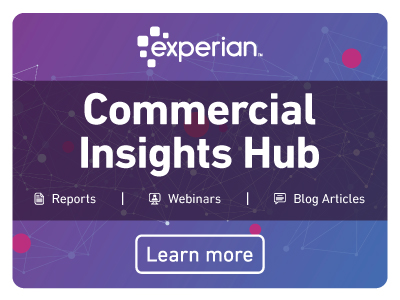Financial Services

I have been on the road meeting with clients at advisory events, forums, and industry thought leadership conferences, and what I continue to hear is a concern about the upcoming recession. The drivers of the next recession are up for debate but the consensus is that it is inevitable. The U.S. Economy is complex and the signals are mixed as to where the greatest impact will be felt. Protecting your business, whether consumer or commercial focused, is dependent on the stability and strength of your lending criteria and customer engagement practices. You want to protect your customers as well as your business in the case of a market stumble. You are laser-focused on making the best possible decision when reviewing credit applications and setting loan terms, however, financial situations change over time for both individuals and companies. This is especially true when a recession hits and unemployment begins to rise, consumers stop spending, and commercial delinquencies begin to rise. When these macroeconomic changes occur, the credit you have extended to your portfolio might be at under market stresses and at a stronger risk of nonpayment, and this can affect your business’s health and sustainability. By stress testing your portfolio, you can determine what may happen, when stresses are exerted, by a receding economy, on your portfolio. You can use credit information, macroeconomic data, and alternative data to build models that forecast what is likely to happen in the future and how stresses, will affect the ability for people or businesses to pay their bills. While larger regulated companies may be required to perform forecasting and stress testing, lenders of all size can benefit from the process. Gathering the Right Data for Accurate Stress Testing The accuracy of your stress test depends on the type and quality of data used for forecasting. Recessions are cyclical and likely to re-occur every few years, it is recommended that companies use historical data from the 2008 recession for analysis and to make accurate predictions. Young businesses may not have complete historical data going back to the 2008 recessionary time period. A partner like Experian can create look-alike business samples, from the vast holistic data, to simulate the likely impact of macroeconomic scenarios. For example, a financial services firm has been providing small business loans between $50,000 and $100,000 for the past three years and wants to predict future losses. To gather the data for loss forecasting, you need to create a business and product profile identifying loans or businesses with similar characteristics, to stress and forecast performance. These profiles are used to build a look-alike sample of businesses and loan products that look and perform like your current portfolio and will add the sample size and retro time periods needed to create a statistically viable analysis sample. Selecting a Forecasting Strategy Once you have the historic credit, macroeconomic, and alternative data on your portfolio or look-alike retro sample for modeling, you need to stress test the data. Most stress test analyses start with a vintage based analysis. This type of analysis looks at the performance of a portfolio across different time periods (Example: March 2007, March 2008, March 2009, etc..) to evaluate the change in performance and the level of impact environmental stresses have on the portfolio's performance. Once you have this high-level performance, you can extrapolate into the future performance of the portfolio and set capitalization strategies and lending policies. Identifying Loss Forecasting Outcomes Regulators and investors want to know the business is solvent and healthy. Loss forecasting demonstrates that your company is thoughtful in its business processes and planning for future stresses. For regional lenders that are not regulated as closely as large national or global lenders, forecasting shows investors that they are following the same rules as larger regulated lenders, which strengthens investor confidence. It also demonstrates effective management of capital adequacy and puts you on a level playing field with larger lenders. Companies with limited data can start with credit data for look-alike sample development and add historical data and alternative type data as they grow for a holistic portfolio view. Setting up Governance Business policies and macroeconomic stresses change over time, it’s essential to set up a governance schedule to review forecasting processes and documentation. Your stress testing and forecasting will not be accurate if you design it once and do not update it. Most companies use an annual schedule, but others review more frequency because of specific circumstances. Effectively Documenting Loss Forecasting The key element of loss forecasting is effectively documenting both sample and strategy taken in the evaluation of your portfolio. A scenario you might face is when a regulator looks at the analysis performed and you have selected sample data at the business level instead of the loan level, documentation should capture the explanation of why you made the decision and the understood impacts of that decision. While the goal is to have complete data, many companies do not have access to high-quality data. Instead of foregoing loss forecasting, the use of documentation to note the gaps and build a road-map for the data can be of great value. Here are additional key points to include in the documentation: • Data sources • Product names • Credit policies • Analysis strategy • Result summary • Road-map and governance schedule By creating a stress-test analysis strategy for forecasting loss, your company can make sure its portfolio and financial status remain as healthy tomorrow as they are today while maintaining transparency and investor confidence. The next recession is out there, this is a great time to strengthen processes for future successes.
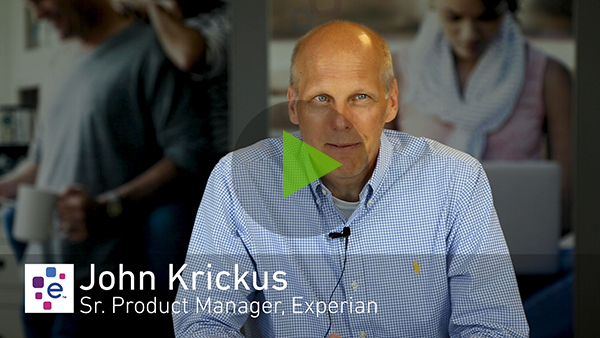
We sat down with John Krickus, Senior Product Manager for Experian's Scoring solutions to ask about the new Social Media Insight, and how this data and score are being used to help businesses strengthen scoring models, and create opportunities for emerging small businesses with limited credit history but strong social media profiles. What is Social Media Insight? We're very excited to bring what we consider a breakthrough capability. Social Media Insight is an expansion, a use of new information beyond traditional credit data, that both improves the performance of our scores, provides attributes to our clients, and is directly sourced from the social media providers - no screen scraping. What type of social media data is used? So the social media data comes from sources that, like with our other data sources, we are not allowed to publicly disclose, but we are focused on business social media sites. So we're not going after consumer social media data, but social media data from business-oriented sites, so that we can better evaluate small and midsize businesses. What steps are taken to prevent artificially boosting the ratings of a business? So that's a question that we often receive about artificially boosting ratings. We work with social media companies, they have many techniques to identify where the reviews are coming from and to prevent someone gaming the system. Is it 100 percent full proof? No, but it is very effective. How effective has social media data been in predicting risk? As we've seen with using the data in our scoring solutions, we've seen a tremendous boost in score performance. There have been two real gains from using social media data. First is, we've developed about 70 social media attributes. We can now include those attributes and make these attributes available to our clients to improve the performance of risk scores. The second area really devolved from client feedback as we piloted the data. They indicated to us that there were social media data elements that are very helpful. So, we've been able to attain information such as pricing, parking situation, hours of operation, and those additional data elements have also helped our clients in improving their risk performance scores. What type of data do our clients get with Social Media Insight? We're able to provide our clients one of three types of data. First, we can provide a social media IntelliScore. That's our normal IntelliScore with commercial data, and now social media data. So, you get a higher performance. We've boosted performance by 37 percent with our IntelliScore. Second, we can provide those same social media attributes to our clients. So, they can incorporate those social media attributes into their scoring models. And third, we have the descriptive data. I mentioned hours of operation for example, social media data also provides a better description of the business. So, you just don't get an Exercise Gym, you get whether that gym is kickboxing or whether that's just exercise equipment. Can I target specific kinds of businesses? Can it be used for Marketing? We do have the ability to use social media data for identifying better businesses to do business with. Our initial focus though is in developing the attributes and the score for risk management. So that's really the focus for this first phase of Social Media Insight. How might Social Media Insight help an Insurance company? Insurance companies have been very anxious for this data, and they're getting a different view of the business. We're going beyond traditional trade, public record, background information, and now we're able to provide a view of how long has that business been rated? How are the ratings? What's the trend in the number of ratings? So, it's not just your level rating, but are you getting reviews over time? All that information provides a really unique view of the business that we've never seen before. How can Experian clients access Social Media Insight? Our clients can access the data one of two ways. We can provide a batch file. So, if you have a portfolio and you want to add social media attributes and a social media score to that you can provide us a file in batch. We also have our new API access, and we're very excited about that. So that allows you online real-time access to obtain the social media insight data, and it's very easy to program to. Can Social Media Insight help emerging businesses gain access to capital? Yeah that's an excellent area for Social Media Insight. It's really the newer smaller businesses that don't have a very deep credit history, that Social Media Insight now provides a view that previously it may have lacked information, therefore, credit may not have been extended. Now by having a social media site data available. We're adding depth of information to that business. We've actually found that businesses with social media data, as a group, are less risky than businesses without. How does Social Media Insight help improve risk model performance? So, the view that the social media data provides, we have found has boosted model performance, more than doubling model performance for those new emerging businesses. But even for established businesses we've seen double-digit gains in the measure of performance for models such as KS, and again you're getting a view of a business, number of reviews, and we normalized that. So, if you're in an area that's very active with social media data we take that into account. So, if you have 10 reviews in your history, which are in a very active area, you may not get as much of a positive as if you had 10 reviews and a less active social media area. So that combination really boosts performance and predictiveness of the data. How do Social Media Insight help our clients reduce risk? And really that's been one of the biggest breakthroughs with the social media data. Is by being able to boost the performance as I discussed earlier on KS, those new to the world businesses. They now are able to more confidently make decisions in their portfolio, because there is now a wealth of information. They're able to improve their models with this new additional information and have a very good performance improvement with it before and after. So, there's an across the board performance improvement. How does Social Media Insight help to automate the decisioning process? When you have an automated system, you want to have a higher level of confidence. The higher level of confidence you have, the stronger you can, for example, having automatic approve and automatic reject areas. By adding social media data we're able to get a stronger KS performance, which means you have more confidence in the models, and you can now increase the percentage your portfolios that you're putting through either automated or highly automated decision making. It's a significant boost in performance however you cut it. We're very excited about this unique new information source. Social media data is totally different from any other business credit information that's available, and when it's utilized in a model, in a decisioning system, the gain in performance are dramatic, and we're very excited to bring this capability to our clients. Learn about Social Media Insight
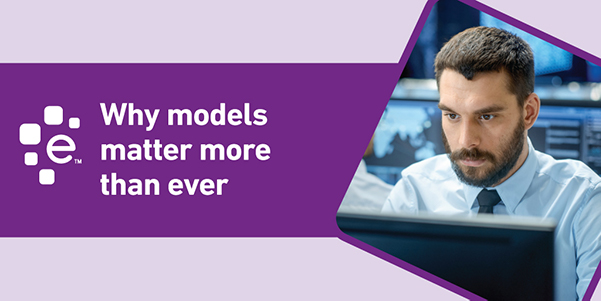
Are the credit models you are using to make lending decisions more than 2 or 3 years old? If so, you are likely making less than optimal credit decisions. You may be turning down a customer who is a good risk — while taking on customers who are more apt to default on their obligations. Every year a model isn’t updated, its accuracy decreases. The economy changes. The consumer’s or business’s financial situation changes. Updating your models, using the most current data and attributes available, you can have confidence that you are making good credit decisions. To make the most accurate credit decisions possible, many businesses are now turning to data-driven decisioning models that are powered by artificial intelligence (AI) within machine learning engines. While the standard regression model works well in some industries, the lift in predictive value from using AI data models can be very important in other industries, such as retail, fraud and marketing. These models use sophisticated algorithms to predict the customer’s future ability to repay their obligation, which means a much more accurate decision than traditional models. Starting with High Quality Data While data has always been at the core of credit decisions, models using machine learning are even more dependent on data. These models can be very accurate, but their accuracy depends on having the necessary data to understand what happened in the past and present behavior to make a prediction for what will happen in the future. The more data provided, the higher the accuracy of the decision. Here are three things to consider when building your data-driven decisioning model: Clean Data – As innovation spurs business and technology to run faster and more efficient, the quality of the data underneath all of that innovation becomes even more important. Machine learning becomes smarter the more data it consumes. This means the accuracy of the credit decisions made by the model is largely dependent on the quality of the data provided. Data from third-party sources often contains mistakes, missing fields, and duplicate information, which results in less accurate credit decisions. Correct Data Points – The accuracy of the results depends on considering the right criteria in the form of data points in the model. When you use machine learning and AI algorithms, they can predict which specific data points will help increase the performance of the model for the specific customer and the specific type of credit decision. Often, data points that you may not consider are the ones that can make a big impact on the accuracy of the decision. Real-Time Data – In the past, there was often significant lag time between collecting and being able to use the data. By using real-time data with machine learning models, you can get a clear picture of the most current view possible and see changes in the different data points as they occur. This lets you make a much more accurate prediction of what will happen, with the consumer or business, than was previously possible with a traditional credit decisioning process. Using Alternative Data to Get the Full Picture Often, additional data — typically referred to as alternative data — that is not readily available from traditional data providers is used to enhance the accuracy and predictive ability of a model. While the model can seem complete without this information, the model may provide suboptimal results without it. Machine learning models can predict the situations and exact type of alternative data a model needs to produce an accurate decision. Experian offers a wide variety of alternative data that clients can use to improve decision models. For example, a business owner may be taking out short-term loans to increase her cash flow, which makes her a much higher credit risk than she appears to be without this data. Weather information is also a common type of alternative data; a business located in Tornado Alley may need higher cash reserves to be a good credit risk. On the other hand, businesses located in an area impacted by a recent weather event, such as a hurricane, may be a good credit risk even with a lower score because both their business and local economy is recovering. Regularly Evaluating Your Data Model You must build in governance and make sure you are evaluating how the model is working on a regular basis, like having an annual checkup with your healthcare providers. Once you begin using a data model, you can’t simply set it and forget it. Ask the following questions to periodically evaluate your models: Are there changes in the outcome of the models? You need to verify that your attributes are still predicting the same outcomes as intended, as well as capturing the same data. For example, say you have an attribute in your model that counts the number of credit lines open for a small business. If the attribute changes and those types of credit lines are no longer reported by the data provider, that number can go from three or four to zero, without there being a change in the number of credit lines open by the business. Because the data that goes into your model has changed, your model is not accurate unless you update the attribute. Is your model stable? You need to make sure that degradation hasn’t reached a point where the predictive value is no longer accurate. For example, scores before the 2008 recession have a different meaning than afterward, due to the changes in the financial system. The future of your business depends on making accurate credit decisions. Instead of using outdated models, use the latest technology and methods available by using machine learning data-driven models. It’s simple. It’s quick. And most importantly, data-driven models are accurate. Related articles: How To Modernize Decisioning with Automation and Real Time Respones Integrating Credit Decisions with the Back Office Improving Customer Experience Through Decisioning as a Service (DaaS)
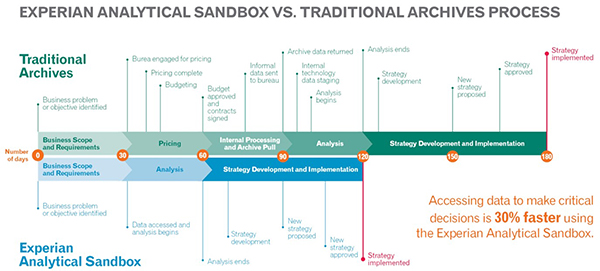
The appetite for businesses incorporating big data is growing significantly as the data universe continues to expand at an astronomical rate. In fact, according to a recent Accenture study, 79% of enterprise executives agree that companies that do not embrace big data will lose their competitive position and could face extinction. Especially for financial institutions that capture and consume an incredible amount of data, the challenge becomes how to make sense of it. How can banks, credit unions, and other lenders use data to innovate? To gain a competitive advantage? This is where analytics sandboxes come in. A sandbox is an innovation playground and every data-consuming organizations’ dream come true. More specifically, it’s a platform where you can easily access and manipulate data, and build predictive models for all kinds of micro and macro-level scenarios. This sounds great, right? Unfortunately, even with the amount of data that surrounds financial services organizations, a surprising number of them aren’t playing in the sandbox today, but they need to be. Here’s why: Infinite actionable insights at your fingertips One of the main reasons lenders need a sandbox environment is because it allows you to analyze and model many decisioning scenarios simultaneously. Analysts can build multiple predictive models that address different aspects of business operations and conduct research and development projects to find answers that drive informed decisions for each case. It’s not uncommon to see a financial services organization use the sandbox to simultaneously: Analyze borrowing trends by type of business to develop prospecting strategies Perform wallet-share and competitive insight analyses to benchmark their position against the market Validate business credit scores to improve risk mitigation strategies Evaluate the propensity to repay and recover when designing collection strategies A sandbox eliminates the need to wait on internal prioritization and funding to dictate which projects to focus on and when. It also enables businesses to stay nimble and run ad-hoc analyses on the fly to support immediate decisions. Speed to decision Data and the rapid pace of innovation make it possible for nimble companies to make fast, accurate decisions. For organizations that struggle with slow decision-making and speed to market, an analytics sandbox can be a game-changer. With all your data sources integrated and accessible via a single point, you won’t need to spend hours trying to break down the data silos for every project. In fact, when compared to the traditional archive data pull, a sandbox can help you get from business problem identification to strategy implementation up to 30% faster, as seen with Experian’s Analytical Sandbox: Cost-effective analytics Building your own internal data archive with effective business intelligence tools can be expensive, time-consuming, and resource-intensive. This leaves many smaller financial services at a disadvantage, but sandboxes are not just for big companies with big budgets. An alternative solution that many are starting to explore is remotely hosted sandboxes. Without having to invest in internal infrastructure, this means fast, data-driven decisions with little to no disruption to normal business, fast onboarding, and no overhead to maintain. For financial institutions capturing and consuming large amounts of data, having an analytical sandbox is a necessity. Not only can you build what you want, when you want to address all types of analyses, you’ll have the insights to support business decisions faster and cheaper too. They prove that effective and efficient problem solving IS possible! Ready to learn more about Experian's Analytical Sandbox and how it can help you optimize your business? Contact Commercial Data Science
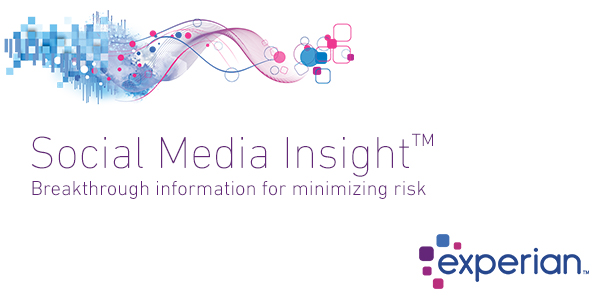
For lenders, alternative data can be the factor in edging out your competitors, especially when better decisions are needed to compete for emerging businesses and startups. Both startups and emerging businesses may represent a good growth opportunity, but they may also be high risk. The challenge? Businesses with thin credit profiles can be difficult to score. Social Media Insight TM provides lenders with another layer of data that can help you better assess the direction of these businesses, score them more accurately and open new growth opportunities. After all, nobody likes to leave money on the table. For emerging businesses who have a thin credit profile but have a strong social media reputation, Social Media Insight can be a factor in gaining access to credit and resources they deserve. Social Media Insight enables you to see the activity, trends and sentiment on a business, over time. In our Experian DataLab tests, we improved overall model performance by 12 percent and new and emerging businesses by 91 percent, boosting predictive performance over traditional data sets. Social Media Insight is directly sourced data providing you with over 70 attributes including trends and sentiment along with descriptive attributes. This powerful data enables you to more accurately score or assess new and emerging business as well as long established accounts. Want to learn more? Watch our on-demand webinar or contact your Experian representative today.
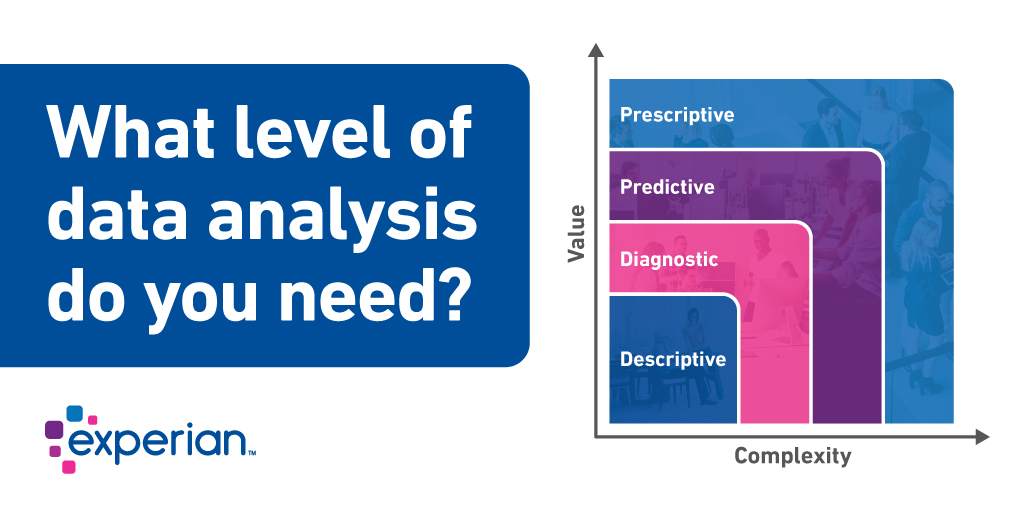
Data analysis surrounding lending practices for commercial lenders falls into 4 distinct buckets that define scope, usability, and purpose. In this post we will discuss how they differ in terms of value and complexity. Descriptive Analytics Descriptive analytics provide the current state of a commercial lender’s acquisitions, portfolio, or other parts of the lending lifecycle. This is “Reporting” in its simplest form. Defining and creating metrics can be as simple as a snapshot of the firmographic and performance elements of a portfolio to complex retro trends that define the effectiveness and success of a lender. Full coverage of the target market and accurate data play a big part in the success of this type of analysis. Selecting the wrong element, when creating a view, can lead the lender to a sub-optimal understanding of the state of their business. Looking at a competitor’s metrics can inform market share and pricing decisions. Experian commercial clients use Portfolio Benchmarking reports as an empirical view into the health of their business compared to their market peers. Adding data visualization on top of the descriptive-analytic reporting quickly closes the gap to a diagnosis. In the map below Texas, California, and Florida have higher rates of account opening and would be attractive target regions for acquisition. Diagnostic Analytics A Diagnostic view of lending performance will look at the portfolio health of a lender and its peers and determine what are the key success and opportunity drivers within comparable products. Larger financial institutions have been performing this type of analysis for years. Several years ago, fintech lending hit its stride challenging the large commercial lenders by providing targeted products in niche lending spaces with little or no traditional commercial credit data. Large commercial lenders used benchmarking and market analysis to understand where the fintechs were being successful. Large lenders use of alternative data sources and market intelligence helped them to recognize the gaps in identifying and evaluating the risk of those underserved businesses. Fintech use diagnostic analysis, to their advantage, to make fast decisions and pivot to market demand. In the chart above, you can see that ABC bank is able to identify where they are offering higher credit limits than their competitors. This client had similar bad rates to its peers causing the lender to have higher losses due to improperly assigned credit limits. Predictive Analytics Predictive analytics can help to scope the effectiveness of a strategic decision and plan for the long-term impacts of credit decisions. Financial institution use this type of analysis to forecast loan performance and plan for impacts to cash flow as economic and market conditions change. Machine learning is used in predictive analysis to be nimbler in the evaluation of vast amounts of data to provide more accurate prediction of future outcomes. Large financial institutions will use Machine Learning in predicting response to an offer through the lifecycle to the collection of outstanding debt. Prescriptive Analytics Predicting potential outcomes within a commercial lender’s strategies only gets them half way to a successful outcome. Providing insight on top of the analytic content is what drives the decisions to stay the course or pivot to an alternate course of action. Prescriptive analytics provides that direction. Machine learning can be used as a tool in prescriptive analytic engagements to develop models that can learn and pivot with changes to the market and behaviors of businesses within that market. Having the capability to adjust actions associated with outcomes allows the model to stay relevant and predictive over a longer period. As customer experience drives lending practices, commercial lenders look to use varying levels of analysis as stepping stones to better serve their small business clients. Got a question about analytics? We would be delighted to answer your questions. Commercial Data Science
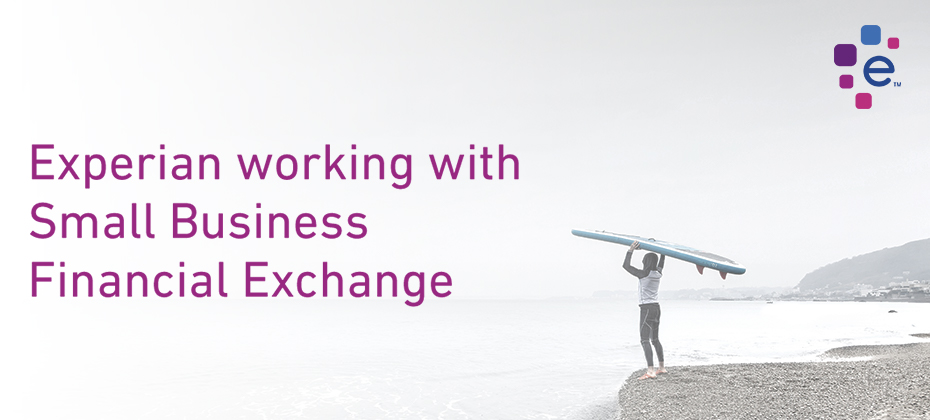
Scottsdale, Ariz., May 22, 2018 — Experian®, at its 37th annual Vision Conference, today announced it has become a certified vendor of the Small Business Financial Exchange, Inc. (SBFE), a nonprofit trade association that gathers and aggregates small-business payment data in the United States to help organizations build a complete picture of small business. “We’re excited to work with SBFE, which shares our mission to bring further innovation to the small-business credit landscape,” said Hiq Lee, president, Experian Business Information Services. “By combining the SBFE’s data richness with Experian’s vast consumer and commercial data assets and leading data science capabilities, we will use the power of data to help our clients make the right decisions.” As a SBFE Certified Vendor, Experian can combine its rich data — including traditional and alternative business data and consumer data on business owners — with SBFE’s data to provide the most comprehensive view of a small business in the market today. For example, financial institutions looking for broad and deep insights on small and emerging businesses will be able to find that information in a way no one has offered previously. Also for the first time, Experian clients that are nonfinancial institutions, such as e-commerce, communications, insurers, and software and hardware vendors, can qualify to access this financial data to help them make confident credit decisions by gaining deep visibility into a small business’s capital use and credit history through Experian. “Experian becoming an SBFE Certified Vendor makes perfect sense in support of our ongoing mission to serve our Members and the small-business community,” said Carolyn Hardin-Levine, CEO, SBFE. “Experian demonstrated its ability to meet SBFE’s high data security and governance requirements, controls, and independent oversight requirements. Additionally, Experian’s ability to deliver blended solutions combined with SBFE data will provide our Members with more options and drive innovation as part of SBFE’s single-feed, multicertified vendor model.” New product pipeline Experian fosters a culture of continuous innovation, from the way it works to the solutions it creates. The company plans to deploy its data scientists to apply leading-edge techniques, including machine learning and artificial intelligence, to discover and provide predictive insights and analytical tools to support better decisioning for its clients. It is anticipated that the work of its data scientists on the combined data sets will result in new product launches over the next 24 months. Vision Conference Each year, Vision combines in-depth research, cutting-edge technology and expertise from industry leaders to help Experian’s clients strengthen their balance sheets and plan for sustained growth. The 2018 conference sold out and runs May 20–23 in Scottsdale, Ariz. Contact: Jackie Brenne Experian Public Relations 1 714 830 5126 Jackie.Brenne@experian.com About Experian Experian is the world’s leading global information services company. During life’s big moments – from buying a home or a car, to sending a child to college, to growing a business by connecting with new customers – we empower consumers and our clients to manage their data with confidence. We help individuals to take financial control and access financial services, businesses to make smarter decisions and thrive, lenders to lend more responsibly, and organisations to prevent identity fraud and crime. We have 16,500 people operating across 39 countries and every day we’re investing in new technologies, talented people and innovation to help all our clients maximise every opportunity. We are listed on the London Stock Exchange (EXPN) and are a constituent of the FTSE 100 Index. Learn more at www.experianplc.com or visit our global content hub at our global news blog for the latest news and insights from the Group. About SBFE The Small Business Financial Exchange, Inc., and SBFE, LLC (collectively known as SBFE) is the country’s leading source of small-business credit information. Established in 2001, this nonprofit association’s database houses information on more than 32 million businesses and enables information exchange among members who provide small-business financing. Through its resources and relationships, SBFE makes possible innovative risk management solutions by providing industry insight and analysis of aggregated small-business financial data to its Members. SBFE is the only Member-controlled organization of its type and is serving as the most trusted advocate for the safe and secure growth of small business. For more information, visit www.sbfe.org.
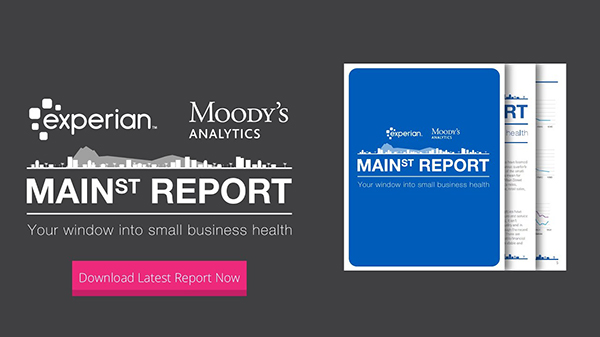
Today Experian Business Information Services releases the Experian/Moody's Analytics Main Street Report for Q1 2018. The report brings deep insight into the overall financial well-being of the small-business landscape, as well as providing commentary around what certain trends mean for credit grantors and the small-business community. Q1 2018 saw credit conditions loosening and balances rising as more businesses access credit. The report states the overall outlook for small-business credit is positive. Delinquencies were down and default rates rose slightly, suggesting that credit conditions have peaked as the economy is in a late-cycle expansion. Continuing strength in the macroeconomy will keep small-business credit moving in the near term, along with higher profits from the recently passed tax legislation. Small-business credit will be less certain in the medium to long term as rising wages, interest rates and changes to the tax code take a toll. Download the latest report
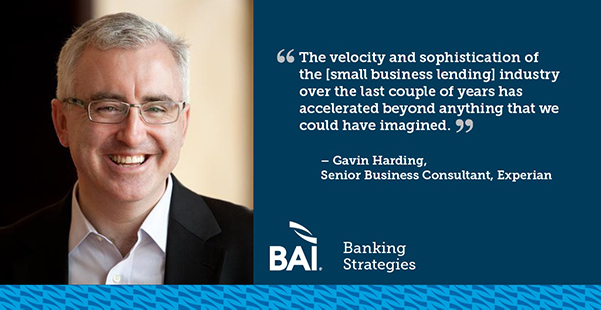
Click image to play the podcast This episode of the BIA Banking Strategies podcast was originally published on BAI Banking Strategies website. [Lou Carlozo]: For small businesses in 2018 the signs and indicators are complex. Bankruptcies are up, but credit conditions have finally shifted for the better. Some remain battle scarred and debt averse from the Great Recession. Yet, others see this as a time to aggressively pursue growth. How can banks make sense of these signs and take advantage of the times? To find out we'll talk with Gavin Harding Senior Business Consultant with Experian. [Lou Carlozo]: Welcome to BAI Banking Strategies where each week we'll focus on the key issues facing financial services leaders. We'll bring you objective opinions and actionable insights that will help you power smart decisions. I'm your host, Lou Carlozo, the managing editor of BAI, come on in. Don't miss our immersive annual event BAI Beacon which takes place in Orlando Florida October 9th through 11th. It takes a team to transform an organization and each team member has their own area of expertise that's critical to the effort. In the BAI Beacon, you can find the topics most relevant to your individual role and regroup at the end of the day with fresh perspective and ideas. Save 50 percent when you register before May 31. To find out more visit www.bai.org/baibeacon. [Lou Carlozo]: Thanks again for tuning into the podcast. It is great to have you here with us. And today on the program we have Gavin Harding the Senior Business Consultant with Experian Decision Analytics Global Consulting Practice. For more than half of his career Gavin held senior leadership positions with a large regional bank gaining experience in commercial and small business strategy, SBA lending, credit and risk management and sales. Gavin great to have you on the podcast today. [Gavin Harding]: Good to be here Lou. Thank you for inviting me. [Lou Carlozo]: Experian in conjunction with Moody's Analytics has this new report out the Main Street Report. Your window into small business health. So are small businesses healthy right now? [Gavin Harding]: Small businesses are very healthy right now. When you think of a small business's performance you think of it two ways one is in terms of you know revenue and overall health, and the other is in terms of access to credit how they pay their bills? For our purposes today we're thinking more about it from a lending banking perspective. From that perspective, bankruptcies are low and have been low for several quarters. Delinquencies are low and have been low for several quarters. So the fundamentals of small business are very robust very strong. [Lou Carlozo]: Small businesses are enjoying a great time. That doesn't mean of course that they're not without challenges and I'm going to read a portion of the report. Bankruptcies continued to rise in the fourth quarter making 2017 a full year in which bankruptcies increased every quarter. Taken alone this isn't good news but bankruptcies are coming off historical lows. Give us a little bit more insight as to what is going on here? [Gavin Harding]: Sure, so let's go back in time a little bit to the dreaded year 2008 when the world pretty much ended in financial terms. Massive turmoil. We tightened up credit. The whole industry worked through a series of losses. After a couple of years those portfolios were pretty well cleared out. So what was left was decent solid businesses with good fundamentals and a lot of the weak players had been essentially weeded out of the market. So time goes on, small businesses slowly start to invest but they were very leery of taking on a lot of debt but they had made it through the war. So those businesses had good credit performance. They were paying their bills and that went on for several years, and for I think it was 14 quarters. We saw that those small businesses continued to pay on time, continued to be good stewards. And then we get to 2017. [Lou Carlozo]: And then what? [Gavin Harding]: So in 2017 there was a lot of change. There had been limited investment from small business for a long time, and there is only so long that you can wait to invest. There comes a point when equipment breaks, when you need to hire people. Businesses became more optimistic. Lenders, bankers, fintech's started to open up the credit box a little bit broader standard. For 14 quarters we saw that those small businesses continued to pay on time, continued to be good stewards in terms of their investment. Good performance, very low bankruptcy levels, and then they really start to get a little optimistic a little confident, money starts to flow. We would expect that delinquencies would increase a little bit over time. We would expect that low bankruptcy rate to increase. So my perspective on that is that while it is something we should keep an eye on. It's very much an indication of growth, of confidence, of enthusiasm and investment. [Lou Carlozo]: What do you see as the most important context heading forward? [Gavin Harding]: The single most common question we have been asked over the last 18 to 24 months is when is it going to turn? And of course if we knew when it was going to turn I would be a retired multibillionaire. So the best we can do is look for indications right? and when we look for indications we look for those on a macro level, unemployment, and as we approach and reach full employment what does it do to wage growth? What does it do to access the human capital? And then we also look at it on a more micro level which is you know within our portfolio what are we seeing that's going to give us that hint? So if we start seeing instead of a gentle upward trend that we might think about in terms of a return to normality, if we start seeing for instance in our credit card portfolios for small businesses, those delinquencies spike, if we start to see those cards maxed out and delinquencies increase, that could be one of those very early signs. The other thing just keep in mind is this, the industry and when I say the industry I'm thinking about finance, over the last couple of years, has transformed in many ways. We all need to have a digital presence. We need to engage customers when they want to communicate with us. And when we need to do that with the products that they're looking for, and at the same time as we deliver this in a very slick quick way we have to maintain good solid robust risk management. And at the same time as we do all of that, we've got to make sure the fraudsters are held at bay and we minimize identity fraud and other types of fraud. So the whole industry has accelerated, it's very much now about digital technology. Customers are looking for quick and ready access. That opens all kinds of other risks for us. We're talking about integrated fraud risk. We are talking about you know advanced analytics on the portfolio. We are talking about operational risk, and our favorite kind of risk, regulatory risk, as we work to comply with regulations that are new and still evolving and haven't been tested yet. So it really is the velocity and sophistication of the industry over the last couple of years has just accelerated beyond anything I think we could have imagined. [Lou Carlozo]: I think the other consequence of this is clients sometimes getting jittery, getting nervous and one of the things that you specialize in is getting into those situations when things don't go as smoothly as a client might like, and offering some remediation, some help keeping things calm and moving forward. Tell us a little bit about how you do that work because you do it so well. [Gavin Harding]: We have clients that have either been in business a long time, or are relatively new to the space and there's often a common feature in the feature is, that they have grown many times grown rapidly, and what they had in place at the beginning was augmented and there was lots of other stuff bolted on. Prime example, banking client, regional bank, 67 separate systems and applications, none of which spoke to each other are connected. So you've got that rapid growth. You hit a certain kind of critical mass and you have to make the decision and the decision is are you going to stop assess, and identify a better way of doing things, and address all of these legacy systems and reports and legacy data and routines and processes? So in many cases working with clients we're able to stand back because we're outside right. We're outside, we know the industry, we've worked with a lot of clients but because we aren't involved in those processes day to day, we can look at them with a cold eye. We can assess them objectively against some of what we've seen other successful clients do. And in many cases, take heavily manual paper based processes and reports and decision making, and make it a lot more efficient, and by efficient, I don't mean you know automatic approvals I don't mean artificial intelligence. I mean old fashioned efficiency. So instead of doing something in ten steps can you do it in three. And when you take that analysis and you spread it across commercial lending for example, or through small business lending, there are some real opportunities to transform the process, to transform the experience of the people that have to work within the process, and ultimately to improve turnaround and accuracy the customer experience itself. [Lou Carlozo]: Turnaround accuracy. I would say this the banks and financial institutions are very fortunate to have you on their side. Gavin I want to thank you for making the time to be on the podcast today it was a real privilege. [Gavin Harding]: My pleasure. Thank you. [Lou Carlozo]: Gavin Harding is a Senior Business Consultant with Experian Decisions Analytics Global Consulting Practice. You can look for Gavin on LinkedIn. And here are three key takeaways from today's podcast: Bankruptcies are up for small businesses. In fact for four consecutive quarters in 2017 according to the Experian report. But that deserves a long view, post-recession. The small businesses that survived became very debt averse while banks tightened up lending. For small and medium sized businesses 2017 also marked a turning point to address needs such as replacing worn out equipment, or hiring badly needed staff. Some businesses haven't made it but it's nothing like the recession and it's a wave of doom. For small businesses in 2018 the news remains very positive, fundamentals are strong. Full employment is here, but there will always be potential storm clouds to keep an eye on. One is credit card delinquency spikes, another, moving too fast to address risks such as fraud. Businesses that have experienced rapid growth often suffer from bolted on systems and unconnected applications. In this case rapid growth means slowing it down. It comes down to four steps, stop, assess, identify and address. The endgame, find and implement efficiencies. [Lou Carlozo]: And now BAI Banking Strategies brings you the aha moment where our podcast guest shines a light on that point in time where realization revelation or exploration made all the difference in their financial services career. Now sometimes before you climb a mountain you've got to dig a hole and here Gavin Harding recalls how a visit from a federal regulator taught him a humbling lesson that he carries with him to this day. Listen. [Gavin Harding]: So let me take you back to Philadelphia in 1999. Being young and educated I was absolutely sure for a certainty that I knew pretty much everything I needed to know. And into that office walked a Federal Reserve auditor. He asked me a series of questions which I immediately answered, and over the course of an hour I dug a hole maybe 20 feet wide by 30 feet deep. Nice straight sides and I climbed on down into it. It took seven weeks and hundreds of files to undo the damage I did with reacting, with feeling, feeling that there had to be an answer that would be an answer now. With feeling that, as an executive, I had to have the answers. So my lesson from that experience and I keep it with me every day and it is part of every interaction with clients. First pause, and then clarify. So make room to think, understand that I didn't have to give an answer. Understand that "I'll get back to you" was a much better answer than a whole series of statements that may or may not have been connected, and were not thought out and were not researched. So I am greatly appreciative to the Federal Reserve for training me in 1999 in Philadelphia. This episode of the BIA Banking Strategies podcast was originally published on BAI Banking Strategies.
